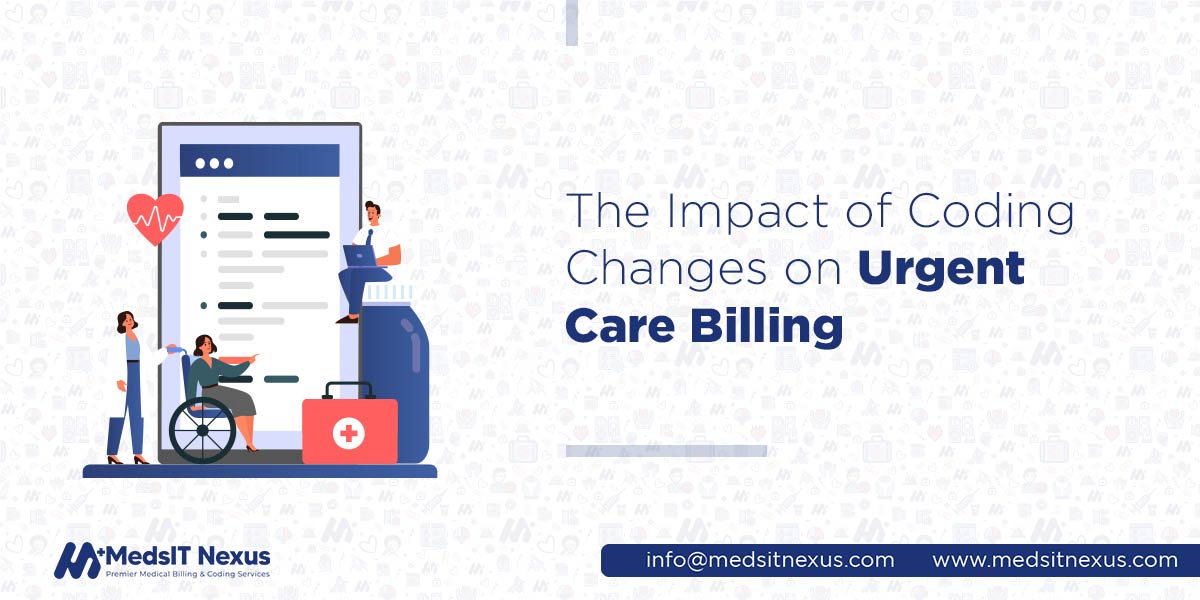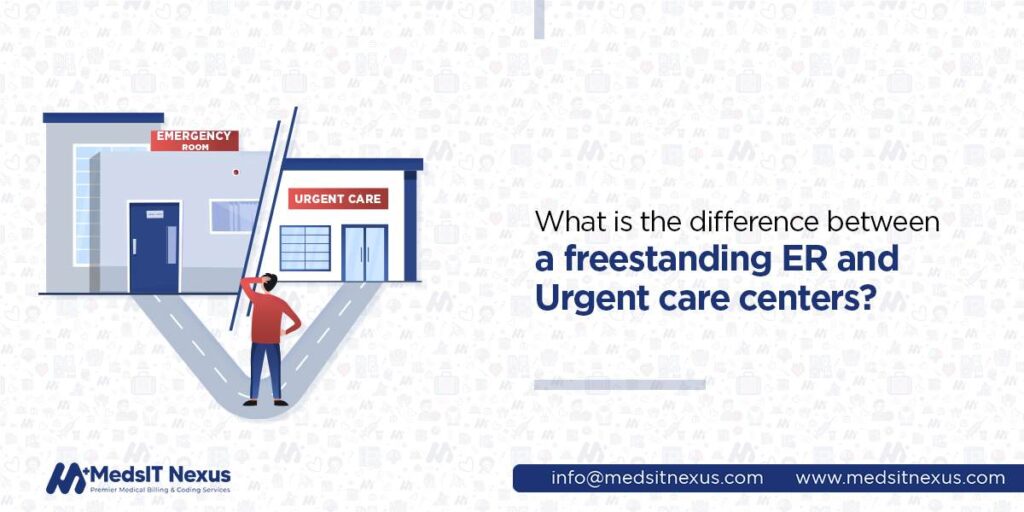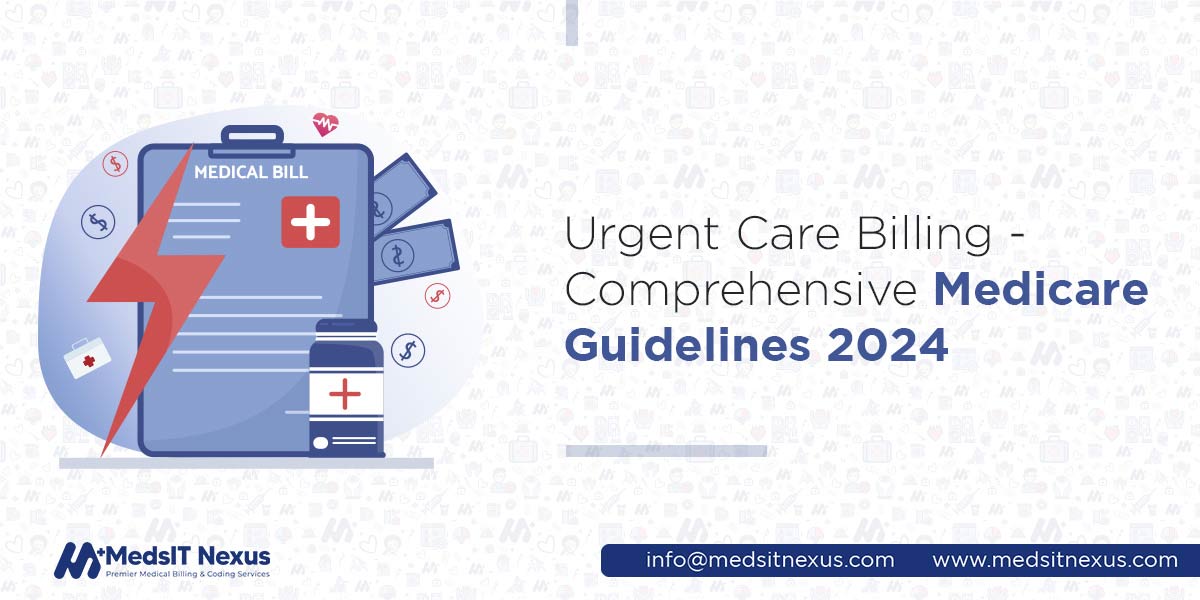The Impact of Coding Changes on Urgent Care Billing

Balancing coding accuracy and productivity is challenging because the Center for Medicare and Medicaid
issues updated or new codes on the 1st of January of every year; sometimes, code updates are issued each
quarter per year. While urgent care codes are updated frequently, it is becoming difficult for
healthcare providers, coders, and billers to keep up and check new coding guidelines. This constant
fluctuation makes insurers struggle with how often to react to update their reimbursement schedules.
Moreover, it also brings challenges for healthcare providers regarding updating their records and
billing. ACA puts forth strict documentation rules; hence, urgent care billing professionals must be
100% correct regarding coding. This is only possible when they stick to updated coding guidelines;
otherwise, several negative consequences may occur.
Nevertheless, it is not easy to do so if you do not have experienced and professional coders who are
well-versed in staying updated and adapting quickly to these changes. To ease the task, MedsIT Nexus
feels proud to offer its valuable services across the USA because it is equipped with skillful and
flexible billing and coding staff.
Understanding the impacts of urgent care coding changes
When we say coding changes, it means updates and revisions (deletion & addition) of codes used to
translate urgent care services and procedures, affecting how urgent care providers document and bill for
their services.
CPT codes are often changed to render advancements in services, technology, and procedural changes. As
of 2024, some urgent care CPT code changes and its selection criteria include:
Change # 1: CMS requires urgent care providers to complete patient history and patient
examination in order to report CPT codes. CMS says that the following criteria must be implemented while
choosing CPT or E/M codes:
- Medical decision-making (MDM) level
- The time spent on the day of the encounter
- Time requirement has shifted from face-to-face time to total time spent on encounter day
Change # 2: Another significant change is the inclusion of a new code, 99417, which is a prolonged service code for visits of more than 59 minutes.
Change # 3: Some changes occurred in the procedure code, such as new codes for
antibiotics & contrast injections, revision in codes for wound repair, and some neurostimulator codes.
As a matter of fact, the impacts of these changes can be both positive and challenging; let's have a
glimpse.
Negative impacts
Workflow adjustments
Changed codes and rules add more complexity and challenges to the coding and billing process, necessitating urgent care billers and coders to adjust existing workflow. This may include implementing new software and attention to detail to adapt to new changes that require extra effort, time, and skills, which is challenging.
Time constraints
When there are code changes, adapting and implementing them requires time; hence, meeting deadlines for employing new codes during claim formation becomes complex and stressful at the same time, leading to documentation inaccuracies, omission of crucial tasks, and foregoing activities that foster good revenue.
Compliance violation
Coding compliance in urgent care billing means adherence to updated and established coding standards and guidelines, such as utilizing accurate HCPCS codes (S codes) and CPT (E/M) codes. CMS code changes for urgent care services often introduce new documentation requirements and guidelines that healthcare providers and billing staff must follow. Failure to stick to these guidelines may lead to coding compliance violations.
Potential for errors
The Office of Inspector General (OIG) says that the best practice is to achieve more than 95% coding
accuracy, and one of the essential components of coding is staying compliant with coding changes and
updates. Urgent care coding and billing often change, and your staff may be unfamiliar or unknown to new
coding guidelines, so there is more potential for increased errors. These errors may encompass:
Upcoding: A practice of implementing a higher-level code than what is justified by the
patient's condition or the rendered services, leading to overbilling and abuse.
Downcoding: A practice of implementing a lower-level code that does not reflect the
complexity of a patient's condition, affecting the quality of services and reimbursement.
Claim denials
You may input urgent care codes incorrectly with the chances of assigning old code frequently used previously, or you can implement code change guidelines inappropriately. Using outdated code or outdated guidelines means that you billed the invalid code, and your claim will get denied by insurers using denial codes such as CO-11 (when a diagnosis code does not match with the procedure), CO-18 with RARC N522 (when there is a duplicate claim) leading to revenue loss. It has been seen that approximately $262 billion annually is lost due to claim denial, and not adhering to coding changes may be one of the significant reasons for this denial.
Payment delays
According to the Journal of Urgent Care Medicine (JUCM), improper coding directly causes faulty claims and decreases the clean claim rate and net reimbursement per visit (NRPV). Once a claim is denied, five times more effort is required to collect payment, causing payment delay. At this point, we understand that payment delays cause unwanted financial stress, and according to Sage research, it takes an average of 15 days to chase delayed payments.
Fraudulent practices
If new codes are not employed according to urgent care CMS coding guidelines, it might be considered fraud and lead to penalties. Urgent care fraud comprises billing for unnecessary or undelivered services, rebilling, misrepresentation, unbundling, upcoding, and readmission. Insurance fraud poses significant financial challenges; a few years ago, the US Department of Justice and the Department of Health and Human Services reported the number of fraud recoveries, which was around USD 2.6. According to an estimation of the National Health Care Anti-fraud Association, the fraud costs $68 Billion annually, while estimation is $230 Billion.
Positive impacts
If implemented effectively and correctly, implementing new coding systems or code changes benefits
urgent care providers, patients, and insurers. Code changes result in the following but are not limited
to:
- More accurate reporting system
- Coding and documentation improvements
- Better support for clinical decision
- Improve quality measurement
- Detect and prevent abuse & fraud
Best practices and tips to stay compliant with urgent care code changes
CMS has implemented the National Correct Coding Initiative (NCCI) to foster nationally accurate coding methods and control improper coding. Many commercial insurers use these NCCI edits. The integrity of coding data in urgent care and its transformation into helpful information relies on the consistent adherence of all coders to updated coding guidelines, regulations, standards, and protocols. To meet this, follow the strategies below.
Training and education for guideline adaptation
Coders often make improper code selections of new codes or guidelines due to a lack of education; hence, focusing on this element is a prerequisite.
- Use numerous learning methods such as online modules, classroom instructions, and hands-on practice
- Develop training programs tailored to specific needs
- Provide support and motivation
- Subscribe to official coding authority newsletters & publications to get timely updates.
- Use online resources such as online communities, discussion forums, and websites
- Join webinars and conferences
Implement effective workflow changes
In healthcare, especially urgent care, inattention to workflow might lead to unaccepted systems and
unexpected negative effects. Thus, effective planning and its execution are necessary for implementing
workflow adjustments such as:
Conducting a gap analysis: You should conduct a gap analysis and identify specific
areas where your current workflow needs to be adjusted to meet new changes.
Developing a phased plan: You must create a transition plan to implement new
guidelines, permitting extra time for training and education.
Communicate effectively
It is a significant strategy to clearly communicate with your coding and billing staff about the
official changes in codes and their guidelines so that everyone in your administrative staff adheres to
the same page.
Moreover, collaboration with coding staff helps build trust, reduces uncertainty, and ultimately leads
to the smooth implementation of policies & procedures. To effectively communicate about changes, you
must take some considerations into account, such as:
- Evaluate the changes that need to be communicated, understand when & how new code updates are implemented
- Prepare a well-structured and comprehensive communication plan
- Choose the right channels to communicate with members, such as emails, written notes, meetings, etc
- Clearly outline the changes and explain new policies
- Listen actively to overcome the resistance to employing new changes
- Address any queries by encouraging open dialogue and using easy language
- Guide how to employ the new changes effectively
Outsource to 3rd party
To overcome these changes, it’s a great tip to rely on coding professionals or outsource for beneficial billing and coding outcomes because outsourcing has proven advantageous in getting experienced, cost-effective, and professional coding and billing. Stop stressing; MedsIT Nexus, one of the top urgent care billing companies, is here for you.
Why should you handle your urgent care coding to MedsIT Nexus?
Considering MedsIT Nexus as your urgent care billing and coding partner brings you perks because we are dedicated to staying updated with every minor change of coding and billing and implementing it with accuracy according to industry and insurer standards. Our staff stays connected with AHIMA, AAPC, CMS, and all other official organizations to get updated information, and we modify our strategies according to the requirements of your coding and billing section while staying adherent to official coding guidelines. Moreover, we aim to increase your reimbursement by leveraging our certified coders and billers' cutting-edge technology, efficiency, and skills. We are experts in navigating the ins and outs of your financial health.
Marshall-Russ, Technical Author -
Healthcare IT & Data Systems Analyst at MedsIT Nexus
Edit Technical documentation, workflow automation insights, and data-driven RCM improvement publications following our standard publication protocols.






